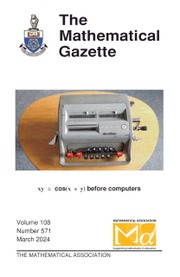No CrossRef data available.
Article contents
Bounds on sums of cubes
Published online by Cambridge University Press: 17 February 2025
Extract
Here we are interested in the familiar identity  but only in as far as it provides the solution (1, 2, …, n) of the Diophantine equation (1)
but only in as far as it provides the solution (1, 2, …, n) of the Diophantine equation (1) where n and the aj are positive integers. In fact, not only is (1, 2, …, n) a solution of (1), it has the remarkable property that, up to a permutation of its entries, it is the only solution of (1) in which the aj are distinct (see Section 4). Thus any other solution will necessarily contain repetitions among the aj and, for this reason, a solution must be defined to be a sequence (which allows repetitions) rather than a set. However, we shall not distinguish between two solutions whose entries are permutations of each other.
where n and the aj are positive integers. In fact, not only is (1, 2, …, n) a solution of (1), it has the remarkable property that, up to a permutation of its entries, it is the only solution of (1) in which the aj are distinct (see Section 4). Thus any other solution will necessarily contain repetitions among the aj and, for this reason, a solution must be defined to be a sequence (which allows repetitions) rather than a set. However, we shall not distinguish between two solutions whose entries are permutations of each other.
- Type
- Articles
- Information
- Copyright
- © The Authors, 2025 Published by Cambridge University Press on behalf of The Mathematical Association



